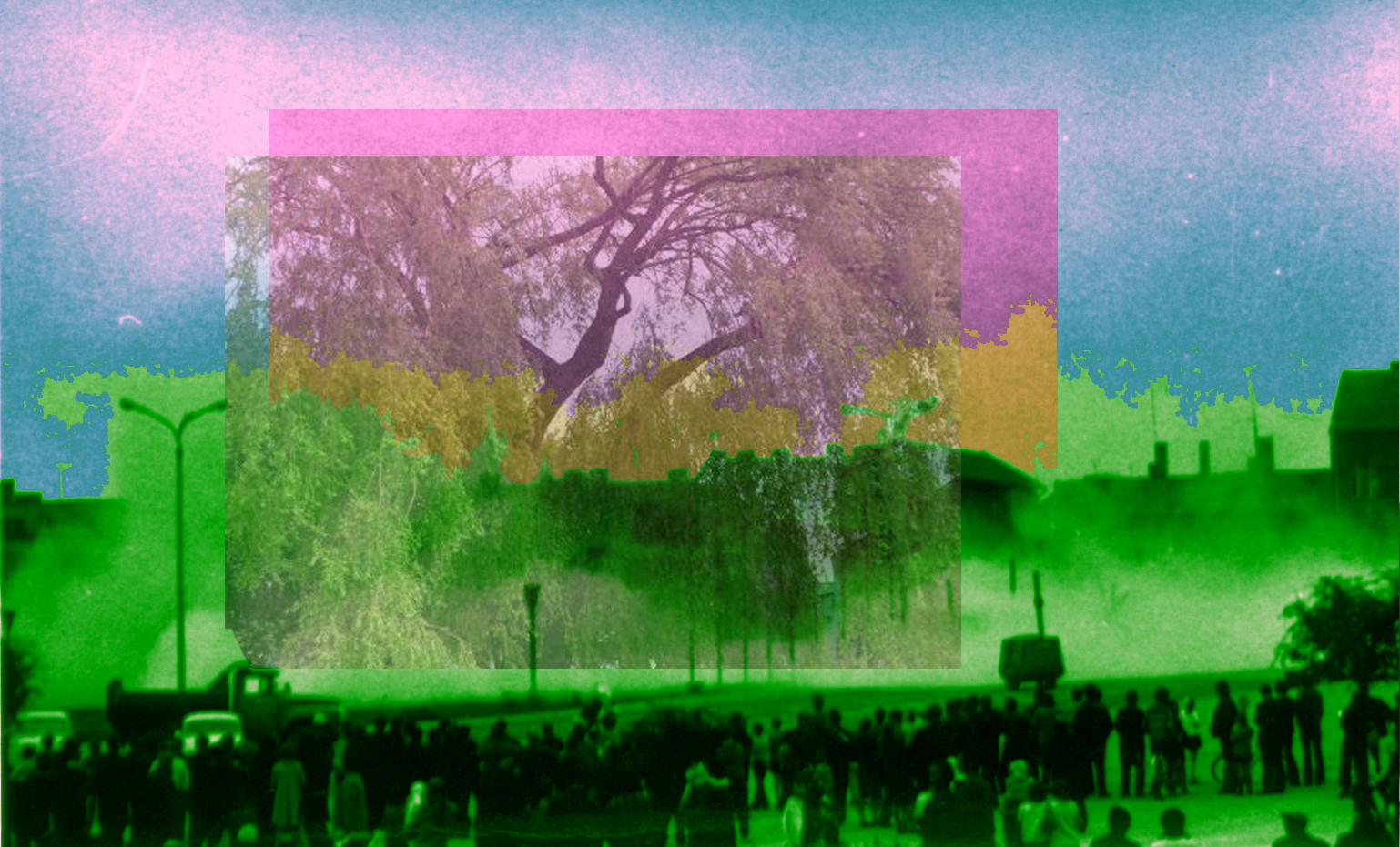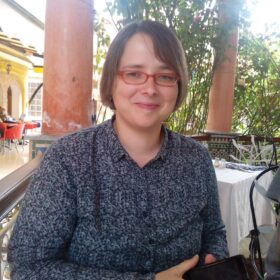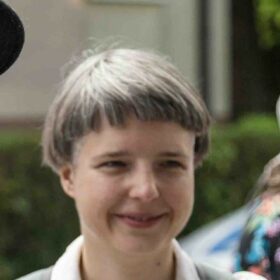Exhibition of the Esther’s Willow project by Katarzyna Sala, Marta Sala and Robert Yerachmiel Sniderman.
The exhibition staged artifacts and documentation from the Esther’s Willow project archive, binding together historical, cultural, and deeply personal layers of the artists’ process and blurring the boundaries between private, artistic, and academic research. Threads of meanings from the various research practices extend centrifugally unto a soon-to-be-planted white willow sapling standing in the center of the gallery.
Beside the gallery’s entrance, the exhibition materials seemingly begin with a simple candid photograph of a shape of thinned grass where a tree had been cut down. Over the photograph is written by hand in Polish, “the place of the willow, Chrzanów 2021, former Esther’s Square.” A narrative builds as visitors follow materials on the wall leading through official, unofficial, and interpretive archives of the former Esther’s Square in Chrzanów, concerning both its present and former built environment and the memories and imaginations of its past and present denizens and descendants.
One sees a scan of the founding document of the Great Synagogue of Chrzanów, photographs of its 1973 demolition, the more recent demolition of a former prayer house, and contemporary events commemorating the liquidation of the Chrzanów Ghetto. There also hang relics of the city: collages made with plaster collected from tenements, fragments of willow branches and foliage, insulating styrofoam, FFP2 masks, epistolary videos, recordings of testimonies and conversations from meetings with former and present residents of the city and people involved in nurturing the memory of the dispossessed Jewish community in Chrzanów. One sees original and artistically manipulated private family photos of two families who lived near the Square, but at different times: the Sala and Wasserteil families, who met each other through the project.
The Wasserteil family lived in Chrzanów until the deportation of the city’s Jewish population. Avraham Wasserteil is understood to have been the last Jewish resident of Chrzanów, as a young teenager hiding within the walls of a building after the last deportations. He survived. Much of his family, including his mother Esther, was murdered in Auschwitz.
The Sala family, who until recently lived through three generations in an apartment on the former Esther’s Square, first moved there after the war in 1948. Wojciech Sala recalled the sound of the dynamiting of the Great Synagogue, and emphasized the importance of acknowledging the continued presence of the apartment’s legacy to his children, Marta and Kasia, informing them that the old willow tree, which had stood in the place of the eradicated synagogue, had been cut down and thereby helped initiate this project.
In manifold ways, Avraham and Wojciech contributed greatly to the ethical, aesthetic, and social development, content, and forms of the Esther’s Willow project. Wojciech passed away a few months before the opening of the exhibition. The 94-year-old Avraham, after announcing he would never again travel, upon learning about the project from his youngest daughter, decided to journey with his family from Israel/Palestine to plant the second willow, Esther’s Willow, the sapling that stands in the center of the gallery, with us.
Woven into the exhibition is a cycle of poems reflecting on the entire process, for instance on Wojciech’s death, articulating a kind of Jewish theology by way of the project and its layered location, typed on paper sheets that were first bathed in a decoction of willow bark.
Traditional cultural-medicinal practices between Jewish and Slavic communities with willows are an important reference here, sourcing the artists with both aesthetic forms but also a political-ethical vantage rooted in deep time throughout the exhibition. An installation of tens of canning jars suspended from the ceiling presents hand-written notes that narrate such traditional recipes and rituals, the glass of the jars magnifying the notes and containing pieces of described materials, for instance, a child’s hair lock or shreds of willow bark. Beneath the jars, in a circle delineated by a rope, stands a small blue barrel filled with silent water that had been drawn from the nearby Vistula River the night before the opening. In the corner, empty canning jars are stacked on a table, similar to those suspended from the ceiling, and are each labeled “Silent Water,” the context for which is explained in a text by Dr. Marek Tuszewicki along with a notice and invitation to participate. On the morning of July 3, 2022, silent water from the blue bucket will fill the empty jars, the willow sapling will be brought to Esther Square, and those willing should fill an empty jar with silent water from the blue bucket, and travel to Chrzanów, accompanying the willow in its adaptation, and help plant it with the silent water.
The exhibition closed a certain phase of the project, showing the creative process from its initiation in 2018 through the search for traces of memory in the city, the collection of memories of its contemporary and former residents, and research on the history, symbolic meanings, and medicinal properties of the white willow, ending with the preparation and invitation of the public to actively participate in a happening – a ceremony of planting a new tree of the eponymous Esther’s Willow in the former Esther’s Square in Chrzanów, in the place where the Great Synagogue, demolished in the ’70s, stood. However, neither would the project end with this happening. The gesture of planting Esther’s Willow initiated a collective need within and between local, regional, and diasporic communities and their institutions to continue nurturing the legacy of Chrzanow’s Jewish citizens and the entangled traditions of communities of difference who lived, now live, and/or will live in the city together, encouraging active participation in practices of noninvasive, green commemoration and sites of shared, traumatic inheritance.
Read a more detailed account and analysis of the Esther’s Willow happening here: „A Willow (Grave) That Knows a Felled Willow (Mourner) That Knew an Eradicated Square (Woman)” by Robert Yerachmiel Sniderman (The Hopkins Review, 2023).
exhibition presenting the Willow Esther project
- exhibition arrangement: Marta and Katarzyna Sala, Robert Yerechmiel Sniderman
- visualization of the archives: Cheong Kin Man,
- video: Katarzyna Sala
- collages and textiles: Marta Sala,
- poems: Robert Yerachmiel Sniderman
- translations of poems: Piotr Mierzwa,
- letter to Esther Wasserteil: Sharon Wasserteil, translation: Dr. Ewa Węgrzyn
- archival photos of the Wassertheil family
- archival photos of the Sala family
- archival materials of the Irena and Mieczysław Mazaraki Museum in Chrzanów
- archival materials of Eugeniusz Kępiński
- text on silent water: Dr. Marek Tuszewicki
- walk of silent water in Chrzanow: Śomi Śniegocka
- translations of video, wall texts, jar installations: Joanna Figiel
- interviewed: Kamil Bogusz, Aneta Drzewiecka, Monika Głuska-Durenkamp, Leszek Morawiecki, Simon-Pierre de Ghaisne de Bourmont, Sharon Wasserteil
- special contributions to the project were made by: Jerzy Jura, Joanna Rajkowska, Magdalena Rubenfeld Koralewska, Anna Sadło-Ostafin, Anna Sala, Wojciech Sala, Szymon Uliasz, Dorota Walczyk, Sharon and Abraham Wasserteil
Project carried out in cooperation with FestivALT, the Irena and Mieczysław Mazaraki Museum in Chrzanów, the Municipal Center for Culture, Sports and Recreation in Chrzanów and Allianz Kulturstiftung.
























